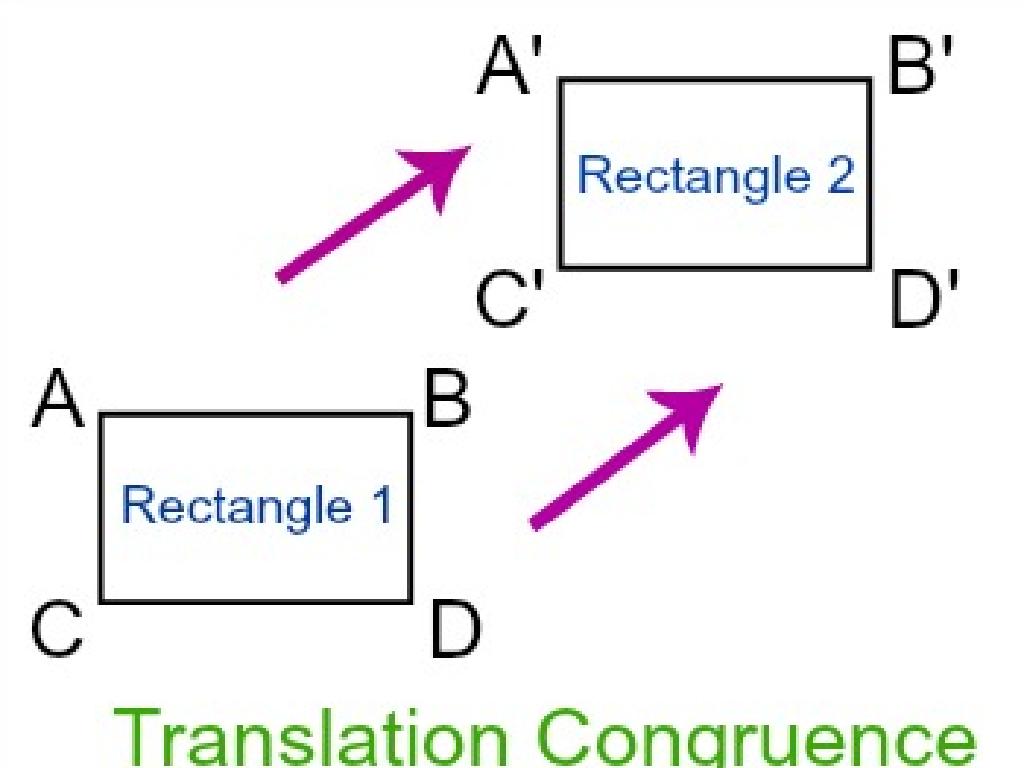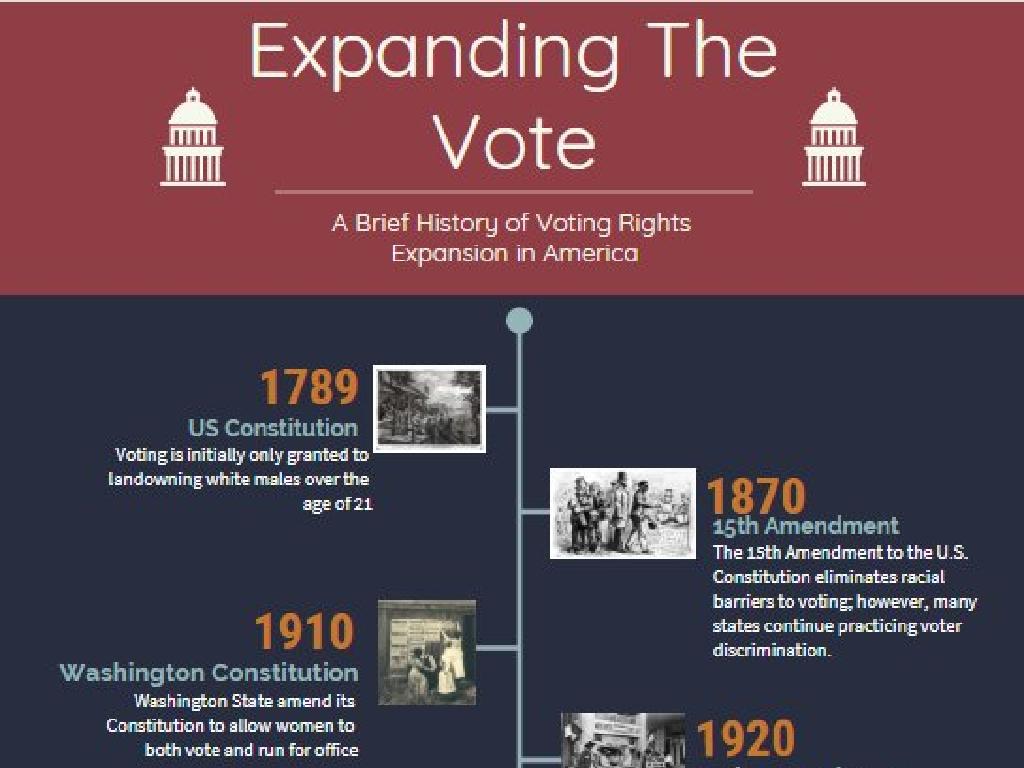Convert Fractions To Percents Using Grid Models
Subject: Math
Grade: Sixth grade
Topic: Percents
Please LOG IN to download the presentation. Access is available to registered users only.
View More Content
Welcome to Percents: Connecting Fractions and Percents
– Percents represent parts of 100
– Daily life applications of percents
– Discounts, statistics, and more use percents
– Fractions to decimals to percents
– 1/2 is 0.5 as a decimal and 50% as a percent
– Using grid models for conversion
– Shade grids to visualize fraction-to-percent
|
This slide introduces students to the concept of percents and their relevance in everyday life. Begin by explaining that percents are another way to express fractions, with the denominator always being 100. Show how percents are used in various daily scenarios, such as in calculating discounts during shopping or understanding statistics in sports. Clarify the relationship between fractions, decimals, and percents, and demonstrate how to convert between them. Use grid models to provide a visual aid for students, helping them to better grasp the concept of converting fractions to percents. Encourage students to practice with different fractions and to create their own grid models as part of their learning process.
Understanding Percents: From Fractions to Whole
– Percent means ‘per hundred’
– It’s like dividing something into 100 equal parts.
– Percents in daily life
– Used in sales, weather forecasts, and test scores.
– 100% represents a whole
– Just like a full pizza is 100% of the pizza.
– Converting fractions to percents
– Use grid models to visualize the conversion.
|
Begin by explaining that the word ‘percent’ comes from the Latin ‘per centum,’ which means ‘by the hundred.’ This concept is a fundamental part of daily experiences, such as understanding discounts during shopping, weather predictions, or even grades in school. Emphasize that 100% means a complete or whole item, using relatable examples like a whole pizza to illustrate the point. Then, introduce the concept of grid models as a visual tool to help students convert fractions into percents by showing how many parts out of 100 are shaded. This visual representation will aid in their comprehension of how fractions relate to percents in a tangible way.
Fractions to Percents with Grid Models
– Every fraction has a percent equivalent
– Fractions and percents as parts of a whole
– Like a pie cut into pieces, both represent portions
– Using grid models to understand conversion
– Grids visually show how fractions translate to percents
– Practice converting with examples
– Convert 1/2 by shading 50 out of 100 squares on a grid
|
This slide introduces the concept that every fraction can be represented as a percent, emphasizing the idea that both are ways to express parts of a whole. Use grid models to visually demonstrate how fractions are converted into percents, making it easier for students to grasp. For example, a grid of 100 squares can represent the whole, and shading a number of squares equivalent to the fraction will show the percent. Encourage students to practice with different fractions, such as 1/2, 3/4, and 2/5, by shading the appropriate number of squares on the grid to find the percent equivalent. This hands-on activity will help solidify their understanding of the relationship between fractions and percents.
Converting Fractions to Percents Using Grids
– Grids as visual conversion tools
– A 10×10 grid represents the whole or 100%
– Color parts to show fractions
– If 5 out of 10 columns are colored, it shows 1/2 or 50%
– Turn colored fractions into percents
– Each colored part is 10%, so count them to find the percent
– Practice with different fractions
|
This slide introduces the concept of using grid models to convert fractions to percents, which is a visual and interactive method suitable for sixth graders. Start by explaining that a 10×10 grid represents 100%, making it easy to visualize percents. Show how coloring a certain number of grid squares can represent a fraction. For example, coloring 50 squares can represent 1/2 or 50%. Then, guide students to understand that each square is equal to 1% and by counting the colored squares, they can easily convert the fraction into a percent. Encourage students to practice with different fractions, coloring the grids accordingly, and converting them to percents. This hands-on activity will help solidify their understanding of the relationship between fractions and percents.
Converting Fractions to Percents
– Start with a fraction
– Divide numerator by denominator
– Multiply by 100 for percent
– Example: Convert 1/2 using a grid
– Fill 50 out of 100 squares to show 1/2, which is 50%
|
This slide outlines the process of converting fractions to percents using grid models, which is a visual way to understand the concept. Begin by writing the fraction that needs to be converted. Then, divide the numerator (top number) by the denominator (bottom number) to get a decimal. Next, multiply the decimal by 100 to change it into a percent. For example, to convert 1/2 to a percent, students can visualize a grid of 100 squares, filling in 50 to represent 1/2. This shows that 1/2 is equal to 50%. Encourage students to practice with different fractions and use grid models to solidify their understanding.
Converting Fractions to Percents with Grids
– Convert 1/4 to a percent
– 1/4 equals 25% because 1 out of 4 squares is 25 out of 100
– Visualize 3/5 with a grid model
– Draw a 5×5 grid, shade 3 rows to represent 3/5
– Work on 7/10 conversion together
– 7/10 is 70%, let’s fill 7 out of 10 squares
– Practice using grid models
|
This slide is designed for a class activity where students will practice converting fractions to percents using grid models. Begin with 1/4, showing that if a grid is made of 100 squares, 1/4 would be 25 squares, which is 25%. Move on to 3/5, using a 5×5 grid to represent the whole, and shade 3/5 of it. Discuss how this relates to 60%. For 7/10, use a 10×10 grid and shade 7/10 to show 70%. Encourage students to draw their own grids and fill in the appropriate number of squares for each fraction. This visual representation helps solidify the concept of percents as parts of a hundred. Provide additional examples if time allows and ensure each student can demonstrate the conversion process independently.
Class Activity: Fractions to Percents with Grids
– Receive a blank grid model
– Choose and color a fraction
– E.g., select 1/4 and color 25 out of 100 squares
– Convert fraction to percent
– Use the grid to see that 25 squares out of 100 is 25%
– Present your findings
|
In this interactive class activity, students will apply their understanding of fractions and percents using a visual aid. Provide each student with a blank grid model representing 100 squares. Students will select a fraction of their choice, color in the corresponding number of squares on the grid, and then convert the fraction into a percent based on the number of colored squares. This hands-on activity helps solidify the concept that percents are another way to represent fractions out of 100. After completing their grids, students will share their results with the class, fostering peer learning. Possible variations for different students could include using different-sized grids, comparing their colored grids to see different fractions and percents, or challenging them to find a fraction that represents a given percent.
Converting Fractions to Percents: Summary
– Recap: Fraction to percent conversion
– Remember to use grid models as a visual aid for conversion
– Importance of percent knowledge
– Percents are used in daily life, like in sales tax calculations
– Open floor for questions
– Review key takeaways
– Ensure understanding of grid method and its application
|
This slide aims to summarize the lesson on converting fractions to percents using grid models. Start by reviewing the steps for conversion, emphasizing the use of grid models as a visual tool to help students understand the concept. Highlight the importance of understanding percents in real-world contexts, such as calculating discounts and interest rates. Open the floor for any questions to clarify doubts and reinforce learning. Conclude by reviewing the key points of the lesson, ensuring students are comfortable with the process and understand how to apply this knowledge in practical situations.
Homework: Fractions to Percents with Grids
– Convert 1/3, 2/5, 4/8 to percents
– Fill grids to visualize fractions
– Use grid models for conversion
– Grids show fractions as percents
– Understand each step taken
– Ensure clarity in each conversion step
– Discuss methods in next class
– Share your strategy with the class
|
This homework assignment is designed to reinforce the concept of converting fractions to percents using grid models. Students will practice with three specific fractions, visualizing them on grid models to better understand the conversion process. It’s crucial to guide students to divide the grids into equal parts and shade the corresponding sections to represent the fractions. Then, they can easily see what percentage of the grid is shaded. Encourage students to write a step-by-step explanation of their conversion process to facilitate discussion in the next class. This will help them articulate their understanding and learn from others’ methods.





